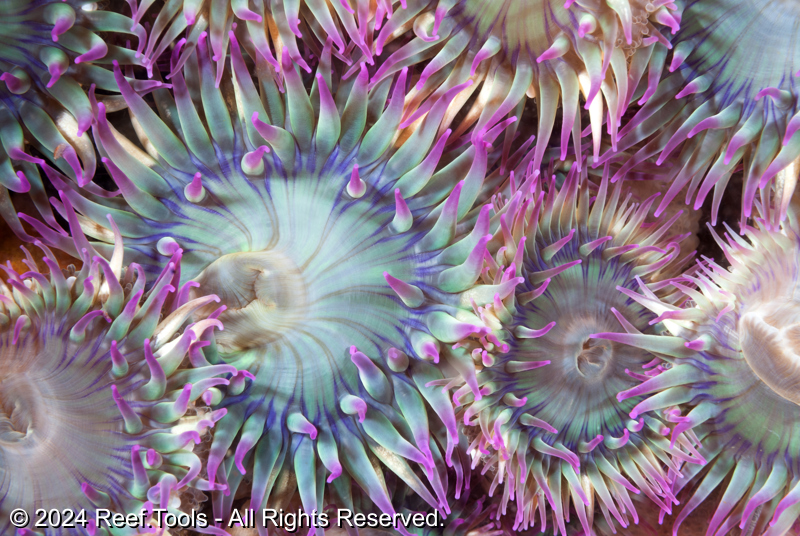Iodine (I)
Halogens
Atomic Number: 53
Last Reviewed: 12/15/2024
Iodine (I) is a halogen element present in marine environments, existing in various forms such as iodide (I⁻), iodate (IO₃⁻), and organic iodine compounds. In reef aquariums, iodine plays roles in the health of certain organisms, but its management requires careful consideration. Iodine is a trace element in seawater, involved in biological processes of marine life. Its presence and functions in reef aquariums are subjects of ongoing research and debate.
Natural Seawater Levels
Concentration: Iodine concentrations in natural seawater are approximately 60 µg/L (0.06 ppm).
Risks
Overdosing:
- High iodine concentrations can be toxic to corals and invertebrates. Symptoms include tissue damage in corals and stress responses in shrimp and crabs.
- Excess iodine can fuel harmful algal blooms and cyanobacteria outbreaks.
Unreliable Testing:
- Hobby-grade kits often measure only one form of iodine, such as iodide or iodate, leading to incomplete data. Advanced techniques like ICP-OES or ICP-MS are more reliable but not universally accessible.
Recommendation:
- Supplementation should be approached cautiously, with frequent testing using reliable methods. Regular ICP testing is the gold standard for monitoring iodine levels.
Relevancy
Biological Importance:
- Invertebrates: Crustaceans use iodine during molting, and deficiencies can lead to incomplete molts.
- Corals and Macroalgae: Iodine is believed to provide antioxidant properties, helping organisms combat oxidative stress from strong lighting.
- Bacterial Symbionts: Iodine supports the health of bacterial populations in corals, particularly those involved in mucus production.
Natural Forms and Dynamics:
- In seawater, iodine exists as iodide (I?), iodate (IO3?), and organic iodine compounds. Each form interacts differently with biological and chemical processes, complicating accurate measurement and supplementation.
Ocean Values
| Reference Name | Low | High | Optimal | Unit |
|---|---|---|---|---|
| Red Sea Ocean | 40.0000 | 80.0000 | 60.0000 | µg/L |
| Hawaii Ocean | 40.0000 | 90.0000 | 60.0000 | µg/L |
| Australia Ocean(Generic) | 40.0000 | 80.0000 | 60.0000 | µg/L |
Regional Variations
Iodine concentrations can vary based on factors such as proximity to terrestrial inputs and local biogeochemical processes.
Dosage Recommendations
Target Level: Maintain iodine concentrations at approximately 0.06 ppm, consistent with natural seawater levels.
Supplementation: If necessary, follow manufacturer guidelines and adjust based on accurate testing to avoid overdosage.
Handling
Testing: Utilize precise analytical techniques for monitoring iodine levels, acknowledging the limitations of standard aquarium test kits.
Supplementation: Only consider supplementation if a verified deficiency exists, and proceed with caution to prevent toxicity.
Reef.Tools recommends: Maintain Iodine (I) concentrations between 30.0000 and 90.0000 µg/L.
References
- Holmes-Farley, R. (2002). "Chemistry and the Aquarium: Iodine in Marine Aquaria." Reefs.com.(reefs.com)
- Tréguer, P. J., et al. (2021). "The biogeochemical cycle of iodine in the modern ocean." Biogeosciences. (bg.copernicus.org)
- Bruland, K. W. (1983). "Trace Elements in Seawater." In Chemical Oceanography, Academic Press.
Difficulty
Rating: Challenging
- Accurate testing is difficult without ICP analysis.
- Balancing iodine supplementation to avoid both deficiency and toxicity requires precision.
Categorization
Element Type: Halogen
Role: Trace Element
Usually Deficient
In natural seawater, iodine levels are stable at approximately 0.06 ppm. However, in reef aquariums, iodine levels are often found to be low, and here’s why: Rapid Depletion: Salt Mix Variability: Inadequate Testing: While iodine is present in natural seawater and quality salt mixes, its rapid depletion in aquariums means it is commonly deficient unless actively managed.
Essential
Iodine plays critical roles in coral and invertebrate health, macroalgae growth, and bacterial symbiosis. While its importance is less direct than calcium or magnesium, it is still necessary for a thriving reef ecosystem.
Aliases
I, Iodide (I⁻), Iodate (IO₃⁻)
